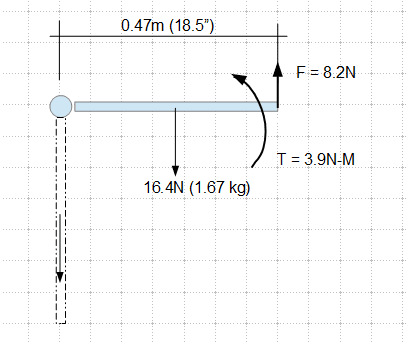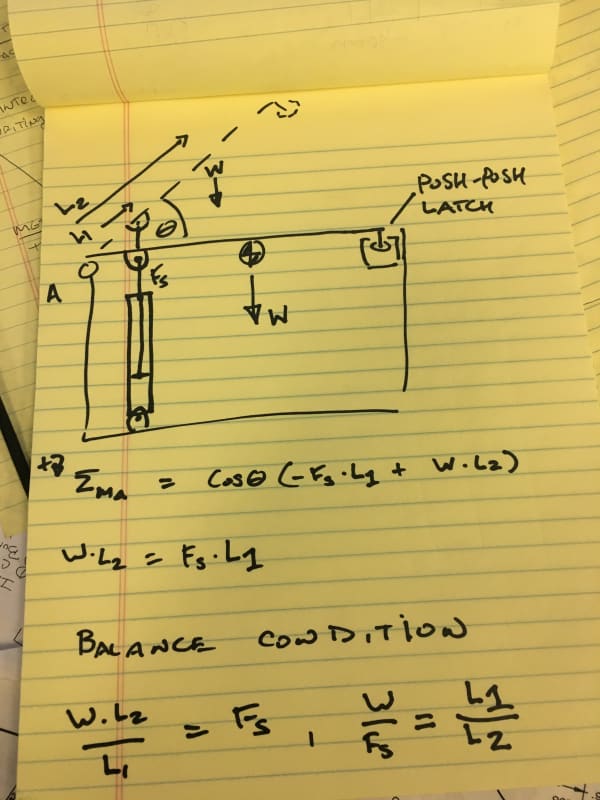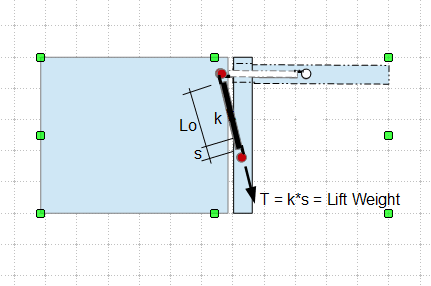My apologies since I am an EE trying solve a mech problem which I thought was easy and it's not. And it has definitely been decades since MECH 230 at NJIT.
The toy chest door/lid is a rectangle of 14" x 18.5" and weights 1.67Kg
The axis/hinge is a threaded rod 10mm in diameter. I attached a wooden disk (Dia. 1.75") sort of as a knob to open and close the lid. Very hard to do by
hand. I calculated the torque required by assuming 1.67Kg on the center of the rectangle times 9.25" = 38.61 N.M
Since my wooden disk had a diameter of 1.75" (44mm), I caluculated that I needed a force of 175.53 N applied on the knob to raise the lid.
I want the normal position of the lid to be in the up/open position. I connceted up 180N of gas springs using a S.S. rope to the outside of the disk (knob) It not only raised the lid, it almost knocked it off of its axis. So much for my tourqe calculation. I experimented and found out that I can do it with a 100 N gas spring. So I want my lid to stay up all the time unless someone closes the lid. Once it is closed the spring can not raise it because I used a kitchen cabinet door (push release) latch to prevent the spring from opening.
The idea is once someone pushes on the closed toy chest door, the latch will release and the toy chest door will go back up to the full open position.
I desperately need help on this. May be a ratchet design with a Pawl and missing teeth on the ratchet gear????
The gas spring was just to try things out. It's too big. I need to build this using Torsion springs. I don't know what size/specifications Torsion spring to use, given that I can raise the lid with 100N applied on the perimeter of the 1.75" dia. disk. How do I dampen the Torsion Spring so that it does not slam up. Last question can and I and wouldn't I be better off using constant force springs. Oh, I want the lid to open up slowly (10 seconds)
Thank you for any assistance or advice.
Not sure if this is allowed. For those of you who are consulting mechanical engineer (as well as others I guess), Obviously I am not doing this for a toy chest. The end product is being patented. I do/will need one or two real mechanical engineers to make this happen.
The toy chest door/lid is a rectangle of 14" x 18.5" and weights 1.67Kg
The axis/hinge is a threaded rod 10mm in diameter. I attached a wooden disk (Dia. 1.75") sort of as a knob to open and close the lid. Very hard to do by
hand. I calculated the torque required by assuming 1.67Kg on the center of the rectangle times 9.25" = 38.61 N.M
Since my wooden disk had a diameter of 1.75" (44mm), I caluculated that I needed a force of 175.53 N applied on the knob to raise the lid.
I want the normal position of the lid to be in the up/open position. I connceted up 180N of gas springs using a S.S. rope to the outside of the disk (knob) It not only raised the lid, it almost knocked it off of its axis. So much for my tourqe calculation. I experimented and found out that I can do it with a 100 N gas spring. So I want my lid to stay up all the time unless someone closes the lid. Once it is closed the spring can not raise it because I used a kitchen cabinet door (push release) latch to prevent the spring from opening.
The idea is once someone pushes on the closed toy chest door, the latch will release and the toy chest door will go back up to the full open position.
I desperately need help on this. May be a ratchet design with a Pawl and missing teeth on the ratchet gear????
The gas spring was just to try things out. It's too big. I need to build this using Torsion springs. I don't know what size/specifications Torsion spring to use, given that I can raise the lid with 100N applied on the perimeter of the 1.75" dia. disk. How do I dampen the Torsion Spring so that it does not slam up. Last question can and I and wouldn't I be better off using constant force springs. Oh, I want the lid to open up slowly (10 seconds)
Thank you for any assistance or advice.
Not sure if this is allowed. For those of you who are consulting mechanical engineer (as well as others I guess), Obviously I am not doing this for a toy chest. The end product is being patented. I do/will need one or two real mechanical engineers to make this happen.



